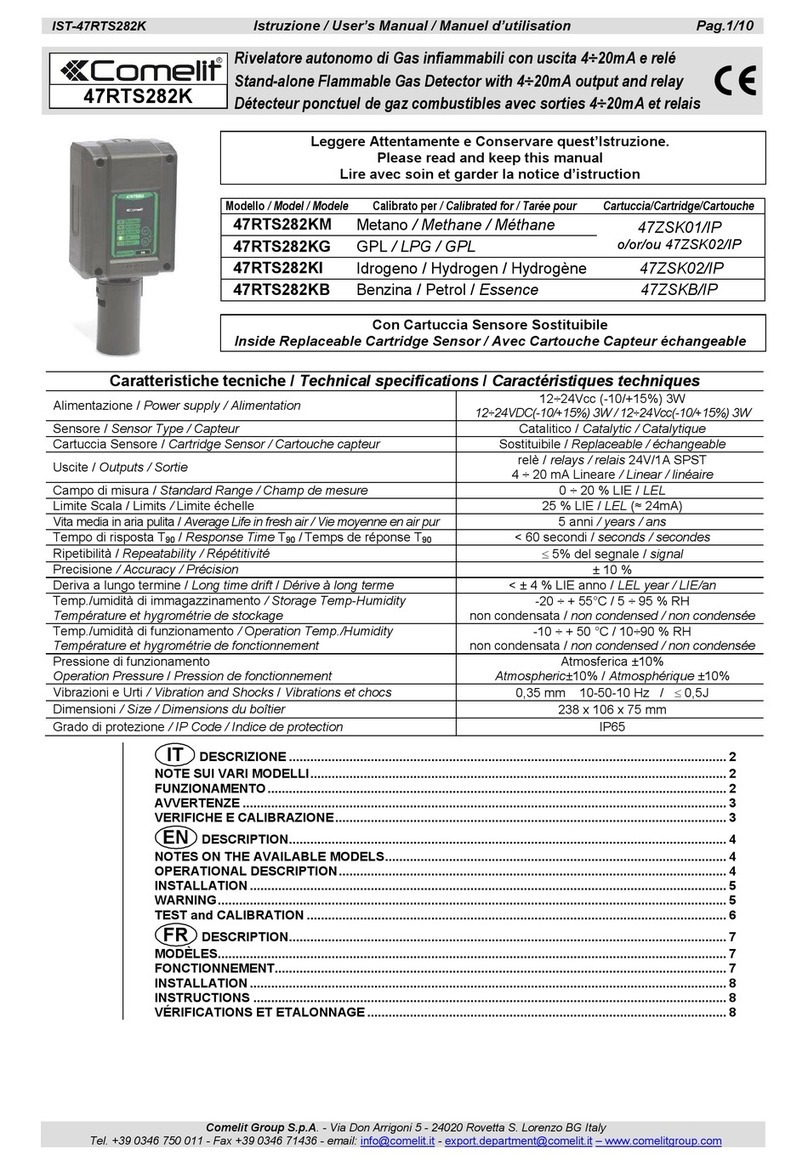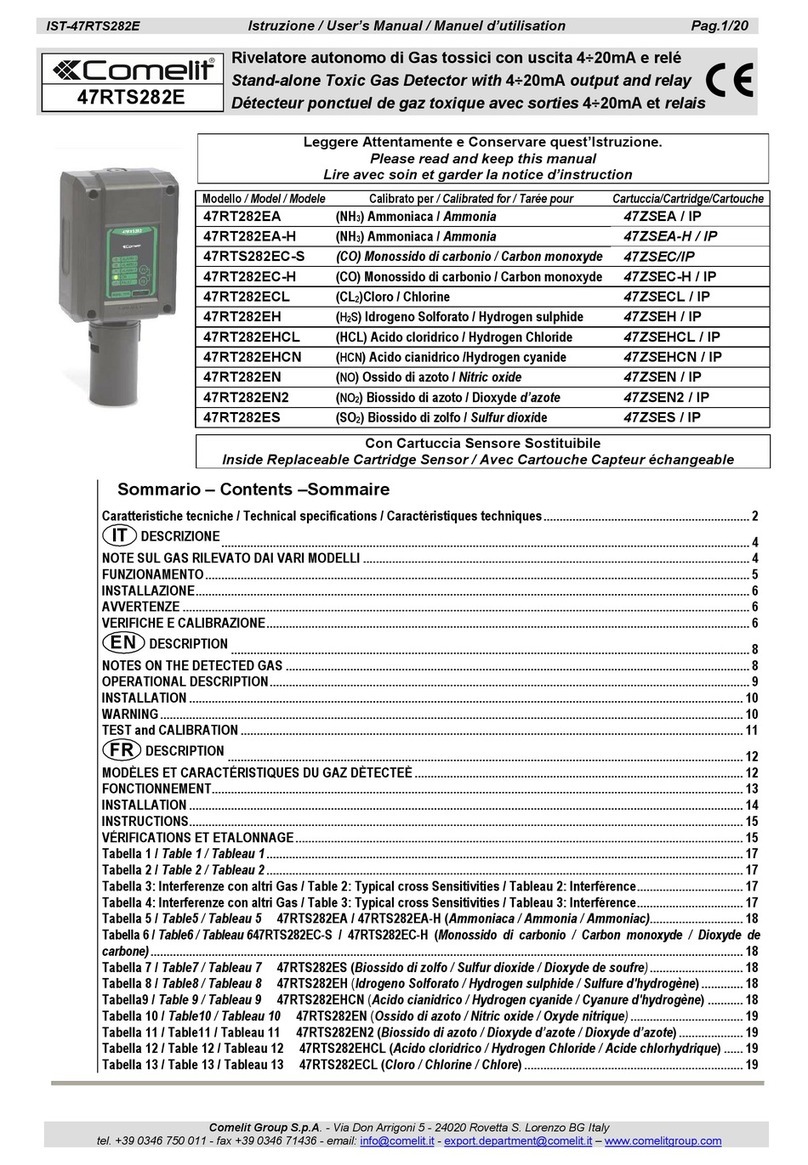
IT
3
1. Descrizione del prodotto
Il rilevatore di gas combustibile utilizza un sensore
semiconduttore di alta qualità, che offre caratteristiche
di elevata stabilità e ridotta variazione della sensibilità.
Con montaggio a soffitto, il prodotto è facile da
installare e comodo da collegare. È ampiamente
utilizzato per il monitoraggio della sicurezza in ambienti
domestici, alberghi, appartamenti e altri luoghi in cui
si possono verificare fughe di gas infiammabili. Può
rilevare gas naturale, GPL e gas di carbone artificiale.
2. Principio di funzionamento
Quando il rilevatore rileva la fuoriuscita di gas
combustibile nell'ambiente e la concentrazione
raggiunge il livello di allarme impostato, il LED rosso
lampeggia e viene emesso un segnale acustico e un
segnale di allarme. Quando la concentrazione di gas
combustibile nell'ambiente scende al di sotto della
soglia impostata, il rilevatore torna automaticamente
alle condizioni di funzionamento normale.
3. Schema
Vedi figura 1 a pagina 2.
4. Specifiche tecniche del prodotto
Tensione di funzionamento 10~24 Vcc
Corrente statica ≤ 100 mA
Corrente di allarme ≤ 160 mA
Tempo di prova 1 minuto
Concentrazione di allarme 7% LEL (deviazione: 3% LEL)
Sensore Sensore a semiconduttore ad alta
stabilità
Metodo di allarme L'indicatore di allarme lampeggia e il
cicalino emette un segnale acustico
Metodo di ripristino Quando la concentrazione di
gas combustibile è inferiore alla
concentrazione di allarme, il ripristino
è automatico
Segnale acustico di allarme ≥ 70 dB
Uscita di allarme Uscita relè, contatto NA/NC opzionale
Temperatura ambiente -10 °C~+50 °C
Metodo di installazione A sotto
Tipo relè 24 Vcc 2 A, 110 Vca 2 A
Umidità relativa ≤ 95%, senza condensa
Dimensioni 95 x 35 mm
5. Installazione del prodotto,
cablaggio e descrizione dello stato
PRECAUZIONI PER L'INSTALLAZIONE
1. Per prima cosa è necessario stabilire se il gas da
rilevare è più pesante o più leggero dell'aria. Gas
più pesanti dell'aria: GPL, ecc. Gas più leggeri
dell'aria: gas naturale, gas di carbone artificiale,
biogas, ecc.
2. Scegliere il luogo di installazione adatto per il
rilevatore in base al gas da rilevare.
Per la rilevazione di un gas più pesante dell'aria:
installarlo a 0,3-1,0 metri da terra, a 1,5 metri di
distanza dalla sorgente di gas.
Per la rilevazione di un gas più leggero dell'aria:
installarlo a 0,3-1,0 metri dal sotto e a 1,5
metri di distanza dalla sorgente di gas. (Vedere
l'immagine 2 a pagina 2)
3. In caso di installazione in un ambiente domestico,
si tenga presente che il rilevatore non deve essere
posizionato troppo vicino ad una cucina a gas,
per evitare che la fiamma dei fornelli interferisca
sul rilevamento; non installare il rilevatore in
un luogo in cui siano presenti fumi in grandi
quantità, per evitare falsi allarmi o un rilevamento
non regolare, con conseguente riduzione della
sensibilità di rilevamento; inoltre non installare
il rilevatore in prossimità di un ventilatore di
aspirazione, sul lato delle porte e delle finestre e
nel bagno dove è presente molta umidità.
4. Eseguire correttamente il cablaggio secondo lo
schema e rispettando le norme e gli standard
nazionali e locali vigenti. Un collegamento non
adeguato causa un allarme anomalo in caso di
fughe di gas.
5. Fissare la staa di supporto del rilevatore alla
parete con le viti di montaggio e appendere il
rilevatore.
SCHEMA DI COLLEGAMENTO
Il rilevatore viene fornito con un cablaggio esterno
predisposto in fabbrica. Il collegamento deve essere
eseguito in base ai colori di identificazione. Di seguito
il significato del colore dei fili: Il rosso indica il polo
positivo dell'alimentazione, il nero indica il polo
negativo dell'alimentazione, il bianco indica il morsetto
comune dell'uscita di allarme, il giallo indica il contatto
normalmente aperto (NA) dell'uscita di allarme, l'arancione
indica il contatto normalmente chiuso (NC) dell'uscita di
allarme, come indicato nel seguente schema:
ARANCIONE: NC
GIALLO: NA
BIANCO: COM
NERO: GND
ROSSO: VCC
DESCRIZIONE DELLO STATO DEGLI INDICATORI E
DEL CICALINO
• Se non alimentato, l'indicatore luminoso è spento.
• Autotest di accensione: Le spie di colore rosso,
verde e giallo lampeggiano lentamente.
• Stato di allarme: la spia rossa lampeggia
rapidamente e il cicalino emette un segnale
acustico di allarme.
• Guasto: Se il sensore è danneggiato, la spia gialla
lampeggia lentamente e il cicalino emette un
singolo segnale acustico per 2 secondi.
• Sottotensione: La spia rossa lampeggia
lentamente e il cicalino emette un singolo segnale
acustico per 10 secondi.
• Stato normale: la spia verde è sempre accesa.


























